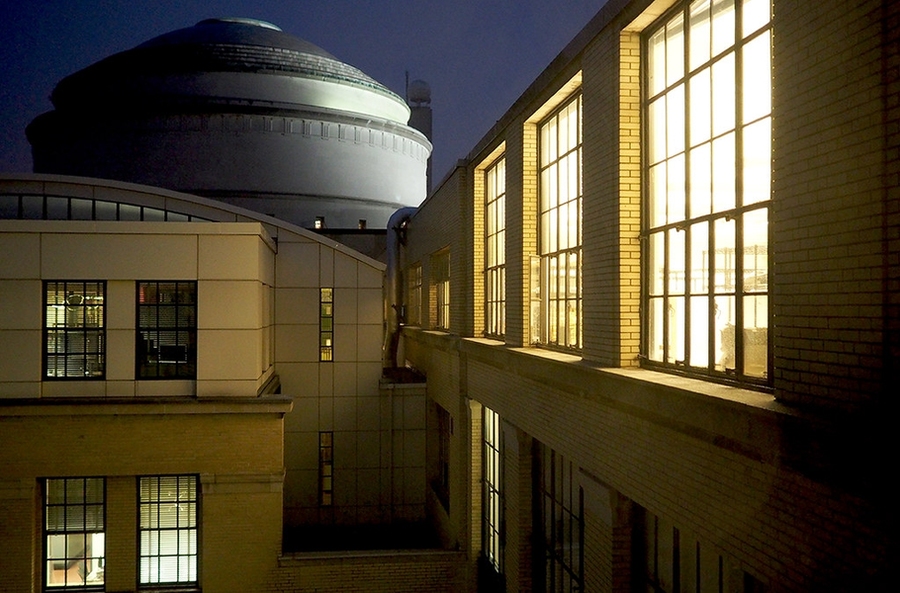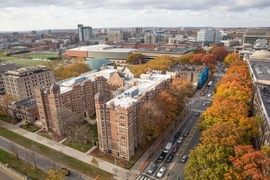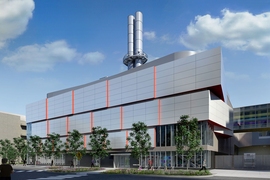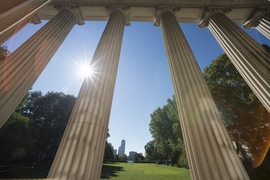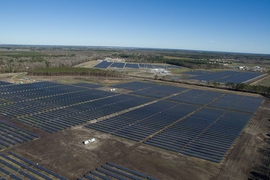At MIT, making a better world often starts on campus. That’s why, as the Institute works to find solutions to complex global problems, MIT has taken important steps to grow and transform its physical campus: adding new capacity, capabilities, and facilities to better support student life, education, and research. But growing and transforming the campus relies on resource and energy use — use that can exacerbate the complex global problem of climate change. This raises the question: How can an institution like MIT grow, and simultaneously work to lessen its greenhouse gas emissions and contributions to climate change?
It’s a question — and a challenge — that MIT is committed to tackling.
Tracking toward 2030 goals
Guided by the 2015 Plan for Action on Climate Change, MIT continues to work toward a goal of a minimum of 32 percent reduction in campus greenhouse gas emissions by 2030. As reported in the MIT Office of Sustainability’s (MITOS) climate action plan update, campus greenhouse gas (GHG) emissions rose by 2 percent in 2019, in part due to a longer cooling season as well as the new MIT.nano facility coming fully online. Despite this, overall net emissions are 18 percent below the 2014 baseline, and MIT continues to track toward its 2030 goal.
Joe Higgins, vice president for campus services and stewardship, is optimistic about MIT’s ability to not only meet, but exceed this current goal. “With this growth [to campus], we are discovering unparalleled opportunities to work toward carbon neutrality by collaborating with key stakeholders across the Institute, tapping into the creativity of our faculty, students, and researchers, and partnering with industry experts. We are committed to making steady progress toward achieving our GHG reduction goal,” he says.
New growth to campus
This past year marked the first full year of operation for the new MIT.nano facility. This facility includes many energy-intensive labs that necessitate high ventilation rates to meet the requirements of a nano technology clean room fabrication laboratory. As a result, the facility’s energy demands and GHG emissions can be much higher than a traditional science building. In addition, this facility — among others — uses specialty research gases that can act as potent greenhouse gases. Still, the 214,000-square-foot building has a number of sustainable, high-energy-efficiency design features, including an innovative air filtering process to support clean room standards while minimizing energy use. For these sustainable design elements, the facility was recognized with an International Institute for Sustainable Laboratories (I2SL) 2019 Go Beyond Award.
In 2020, MIT.nano will be joined by new residential and multi-use buildings in both West Campus and Kendall Square, with the Vassar Street Residence and Kendall Square Sites 4 and 5 set to be completed. In keeping with MIT’s target for LEED v4 Gold Certification for new projects, these buildings were designed for high energy efficiency to minimize emissions and include a number of other sustainability measures, from green roofs to high-performance building envelopes. With new construction on campus, integrated design processes allow for sustainability and energy efficiency strategies to be adopted at the outset.
Energy efficiency on an established campus
For years, MIT has been keenly focused on increasing the energy efficiency and reducing emissions of its existing buildings, but as the campus grows, reducing emissions of current buildings through deep energy enhancements is an increasingly important part of offsetting emissions from new growth.
To best accomplish this, the Department of Facilities — in close collaboration with the Office of Sustainability — has developed and rolled out a governance structure that relies on cross-functional teams to create new standards and policies, identify opportunities, develop projects, and assess progress relevant to building efficiency and emissions reduction. “Engaging across campus and across departments is essential to building out MIT’s full capacity to advance emissions reductions,” explains Director of Sustainability Julie Newman.
These cross-functional teams — which include Campus Construction; Campus Services and Maintenance; Environment, Health, and Safety; Facilities Engineering; the Office of Sustainability; and Utilities — have focused on a number of strategies in the past year, including both building-wide and targeted energy strategies that have revealed priority candidates for energy retrofits to drive efficiency and minimize emissions.
Carlo Fanone, director of facilities engineering, explains that “the cross-functional teams play an especially critical role at MIT, since we are a district energy campus. We supply most of our own energy, we distribute it, and we are the end users, so the teams represent a holistic approach that looks at all three of these elements equally — supply, distribution, and end-use — and considers energy solutions that address any or all of these elements.” Fanone notes that MIT has also identified 25 facilities on campus that have a high energy-use intensity and a high greenhouse gas emissions footprint. These 25 buildings account for up to 50 percent of energy consumption on the MIT campus. “Going forward,” Fanone says, “we are focusing our energy work on these buildings and on other energy enhancements that could have a measurable impact on the progress toward MIT’s 2030 goal.”
Armed with these data, the Department of Facilities last year led retrofits for smart lighting and mechanical systems upgrades, as well as smart building management systems, in a number of buildings across campus. These building audits will continue to guide future projects focused on improving and optimizing energy elements such as heat recovery, lighting, and building systems controls.
In addition to building-level efficiency improvements, MIT’s Central Utilities Plant upgrade is expected to contribute significantly to the reduction of on-campus emissions in upcoming years. The upgraded plant — set to be completed this year — will incorporate more efficient equipment and state-of-the-art controls. Between this upgrade, a fuel switch improvement made in 2015, and the building-level energy improvements, regulated pollutant emissions on campus are expected to reduce by more than 25 percent and campus greenhouse gas emissions by 10 percent from 2014 levels, helping to offset a projected 10 percent increase in greenhouse gas emissions due to energy demands created by new growth.
Climate research and action on campus
As MIT explores energy efficiency opportunities, the campus itself plays an important role as an incubator for new ideas.
In 2019, MITOS director Julie Newman and professor of mechanical engineering Timothy Gutowski are once again teaching 11.S938 / 2.S999 (Solving for Carbon Neutrality at MIT) this semester. “The course, along with others that have emerged across campus, provides students the opportunity to devise ideas and solutions for real-world challenges while connecting them back to campus. It also gives the students a sense of ownership on this campus, sharing ideas to chart the course for carbon-neutral MIT,” Newman says.
Also on campus, a new energy storage project is being developed to test the feasibility and scalability of using different battery storage technologies to redistribute electricity provided by variable renewable energy. Funded by a Campus Sustainability Incubator Fund grant and led by Jessika Trancik, associate professor in the Institute for Data, Systems, and Society, the project aims to test software approaches to synchronizing energy demand and supply and evaluate the performance of different energy-storage technologies against these use cases. It has the benefit of connecting on-campus climate research with climate action. “Building this storage testbed, and testing technologies under real-world conditions, can inform new algorithms and battery technologies and act as a multiplier, so that the lessons we learn at MIT can be applied far beyond campus,” says Trancik of the project.
Supporting on-campus efforts
MIT’s work toward emissions reductions already extends beyond campus as the Institute continues to benefit from the Institute’s 25-year commitment to purchase electricity generated through its Summit Farms Power Purchase Agreement (PPA), which enabled the construction of a 650-acre, 60-megawatt solar farm in North Carolina. Through the purchase of 87,300 megawatt-hours of solar power, MIT was able to offset over 30,000 metric tons of greenhouse gas emissions from our on-campus operations in 2019.
The Summit Farms PPA model has provided inspiration for similar projects around the country and has also demonstrated what MIT can accomplish through partnership. MIT continues to explore the possibility of collaborating on similar large power-purchase agreements, possibly involving other local institutions and city governments.
Looking ahead
As the campus continues to work toward reducing emissions, Fanone notes that a comprehensive approach will help MIT address the challenge of growing a campus while reducing emissions.
“District-level energy solutions, additional renewables, coupled with energy enhancements within our buildings, will allow MIT to offset growth and meet our 2030 GHG goals,” says Fanone. Adds Newman, “It’s an exciting time that MIT is now positioned to put the steps in place to respond to this global crisis at the local level.”
